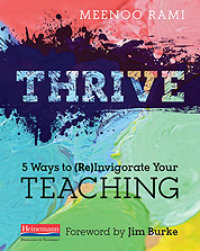Thrive: 5 Ways to (Re)Invigorate Your Teaching
Thrive: 5 Ways to (Re)Invigorate Your Teaching
By Meenoo Rami
(Heinemann, 2014 – Learn more)

In a concise, readable and enjoyable book, Meenoo Rami invites educators to become reinvigorated in five key ways. What educator hasn’t been on their own journey of searching for meaning in our work? Rami shows us — from her own experience and the work of several other educators — that finding meaning helps sustain us as passionate and motivated teachers.

What’s inside
The book is divided into five chapters: Turn to Mentors, Join and Build Networks, Keep Your Work Intellectually Challenging, Listen to Yourself and Empower Your Students. Each chapter provides the reader with Rami’s personal experiences, vignettes from fellow educators, and a guide to get started. As I read, I felt like I was sitting down to have a chat with Rami and I found myself at ease, knowing that I was learning from an authentic educator who is passionate about her work.
Turn to Mentors
In the opening chapter, many educators will be confronted by their own preconceived notions about mentors. Many of us have had the experience of being assigned a mentor our first year of teaching and finding that the relationship is not the lasting mentor/mentee relationship that we need to sustain us. Rami gives us the authority to seek out other mentors and the questions to guide us toward a person who would be a match for our needs.
If you’re like me, this chapter will give you great insight into what kinds of qualities or things you admire and what qualities in another person will help you grow. It also reminded me that it’s not reasonable or even possible to rely on one person as a mentor — just as in the world outside of school, we find numerous people who can enrich our lives.
Join and Build Networks
Chapter 2 is one I will need to keep coming back to because, although I truly know the importance of connection in our profession, I often forget just how important it is and let it drift lower and lower on my list of priorities. In our jobs it’s easy to become isolated and often it even feels more efficient to operate that way. Rami reminds us that we “need to connect as a community of teachers on the local, national and international level to share best practices and support our students’ learning.”
Just as different mentors enrich our lives in different ways, the same applies for different networks. We have networks at school, our personal F2F network, our professional organization networks and our web-based networks. Rami shows how each can contribute to our personal and professional lives and how to get started and contribute to any or all of them.
Keep Your Work Intellectually Challenging
We all know that as easy as it is to become isolated, it’s just as easy to get lost in initiatives, requirements and standards and forget what brought us to the job in the first place. In Chapter 3, Rami empowers us by reminding us “that we are tackling one of the most pressing questions of our time: How do we prepare our students to tackle the complex challenges our world faces?” We meet those challenges by creating our own curriculum, reading widely in our profession, reading for enjoyment, writing and doing our own action research. This may seem like a long list, but Rami points out some small ways that will make us more autonomous and sustain our motivation, even while working within the constraints we all face in schools.
Listen to Yourself
I was intrigued to find Chapter 4 open with a quote from Brene Brown, one of my favorite authors and speakers, about the importance of being daring. Here, Rami encourages us to align our teaching with our values. For many educators, this means facing fears and identifying and overcoming resistance that is in us or that surrounds us. Rami gives us stories from educators who “through cultivating emotional honesty and trusting their intuition…have found a way to align their values with their work.” This self-empowerment helps us remain passionate about our important jobs and relay that importance to our students.
Empower Your Students
What does empowering our students really mean? In Chapter 5, Rami gives us some ideas to build that foundation with our students as we increase engagement, develop momentum and create a lasting legacy. We also learn about ways to give our students a greater audience by expanding our classroom networks and audiences. This idea can seem daunting to some teachers, but Rami includes questions that educators face such as “Is it More Work?” and “How Do I Find Resources?” to allow us to start small.
(Re)Invigorate
This book does exactly that: reinvigorates. It helps us rediscover why we wanted to be teachers in the first place and suggests powerful ways we can grow our practice. We may find that that we are already doing many of the things Rami suggests, but it’s important to remind ourselves why they are so crucial. As educators, we want to (and must) remain passionate – there is no other way to sustain ourselves in such demanding work – and Rami shows us how we can thrive with small steps.
Jessica Valenti is a fifth grade teacher in New Hampshire. She is a beginning blogger, aspiring school leader and an EdCamp Seacoast organizer. You can find her on Twitter @jesslvalenti.




























